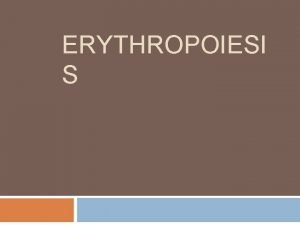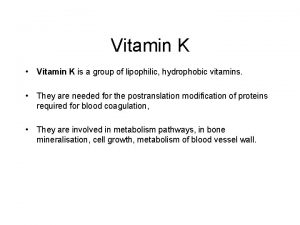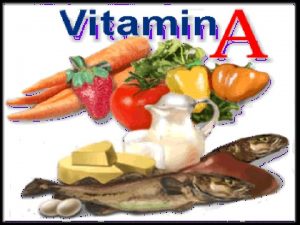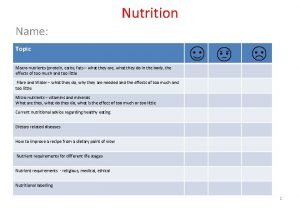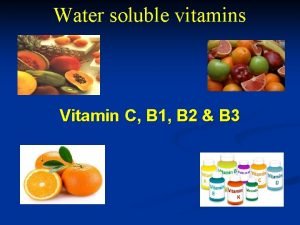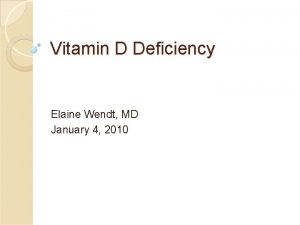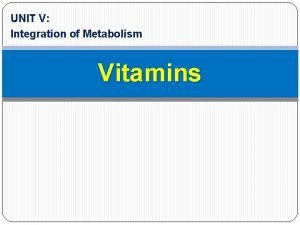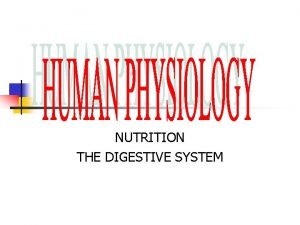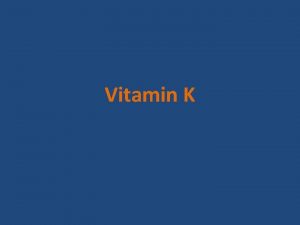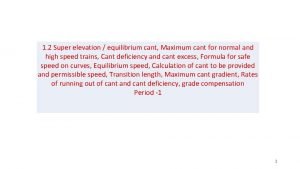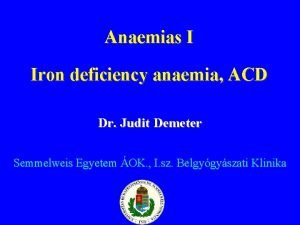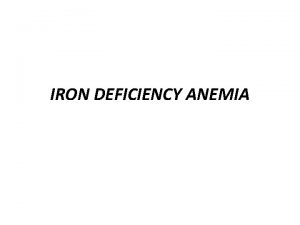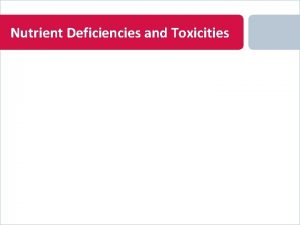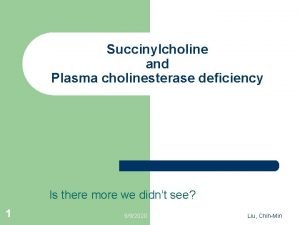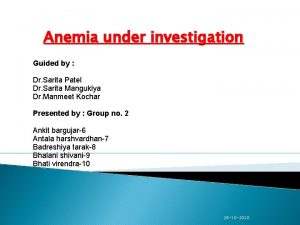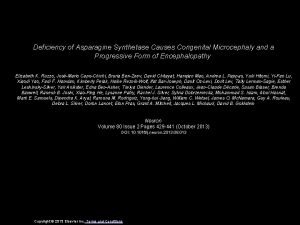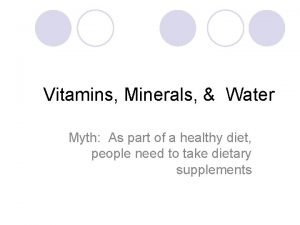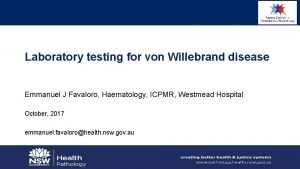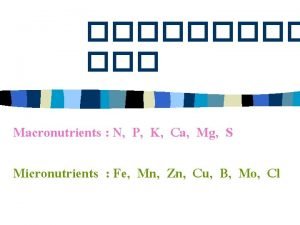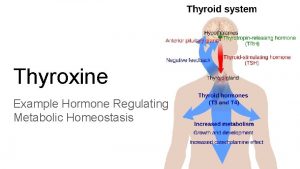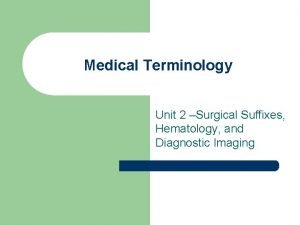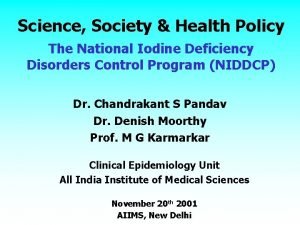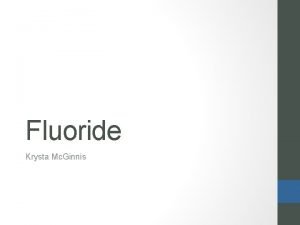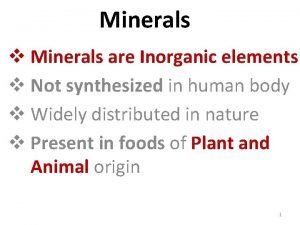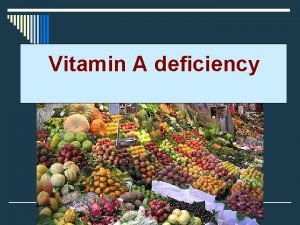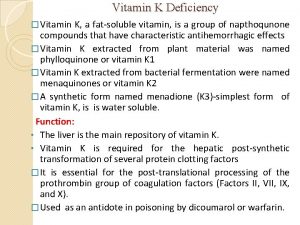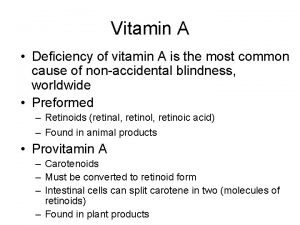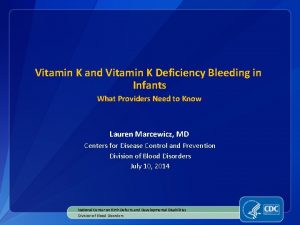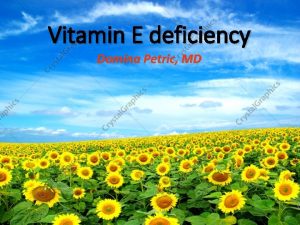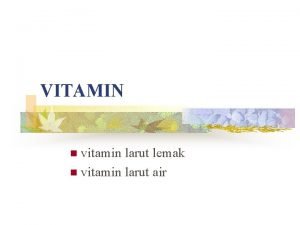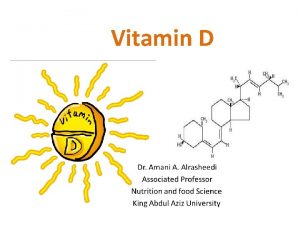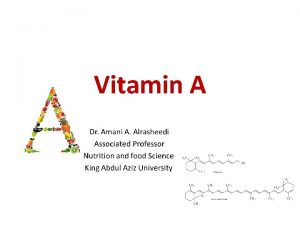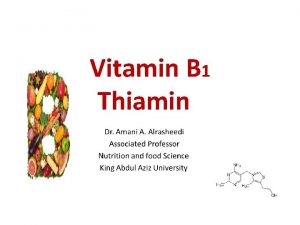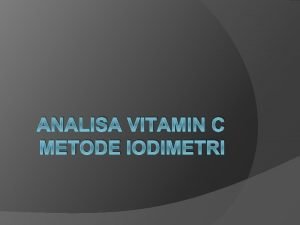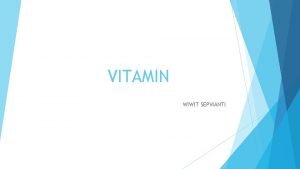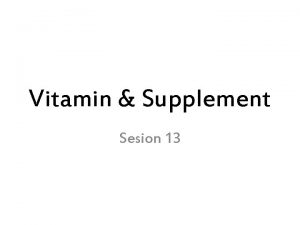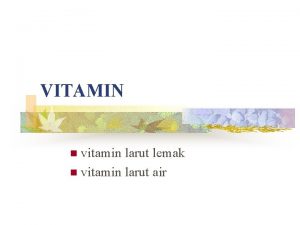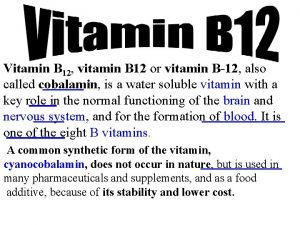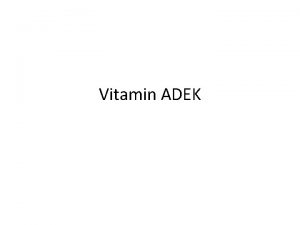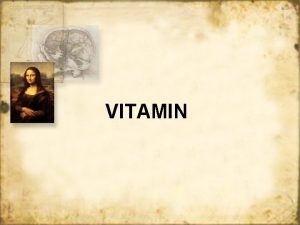VITAMIN D DEFICIENCY 1032020 1 45 50 AM














































- Slides: 46


VITAMIN D DEFICIENCY 10/3/2020 1: 45: 50 AM Mazar-e- Sharif Abu Ali Sena Balkhi Hospital, Power Point ® Lecture Slides prepared by dr Kh Noor M Faiz, 2

Vitamin Etymology The term vitamin was derived from "vitamine", a compound word coined in 1912 by the Polish biochemist Kazimierz Funk when working at the Lister Institute of Preventive Medicine. The name is from vital and amine, meaning amine(organic compound) of life, because it was suggested in 1912 that the organic micronutrient food factors that prevent beri and perhaps other similar dietary-deficiency diseases might be chemical amines. This was true of thiamine, but after it was found that other such micronutrients were not amines the word was shortened to vitamin in English.


VITAMIN D Chemical formula: C 27 H 44 O Melting point: 83 °C Boiling point: 496. 45 °C 7 dehydrocholestrol provitamin D Cholecalciferol vitamin D 3 Ergocalciferol vitamin D 2 Calcifediol 25 dihydroxyvitamin. D Calcitriol 1, 25 dihydroxyvitamin. D

History of vitamin D 1600 s 1 st description of rickets by Whistler & Glisson 1918 Sir Edward Mellanby linked with fat-soluble nutrient 1923 Goldblatt & Soames demonstrated exposure to sunlight or UV light produced a substance with similar properties 1936 Identification of Vitamin D by Windaus

Vitamin D ‘Calciferol’ Generic terms for a group of lipid-soluble compounds with a 3 -ring cholesterol backbone

Vitamin D Deficiency Subclinical deficiency � Silent epidemic. � Present in approximately 30% to 50% of the general population. � More prevalent in elderly, women of child bearing age and infants. � Often unrecognized by clinicians. � May contribute to development of osteoporosis & increased risk of fractures related to falls in the elderly.

Content Source Physiology & metabolism Deficiency & resistance Requirements & Treatment ‘Extra-skeletal’ effects

Sources Of Vitamin D Sunlight (UV) Intestinal absorption (only ~20%) �Oily fish �Fortified vitamin D milk / bread / cereal �Supplements


Vitamin D Metabolism

Absorption & Metabolism Affected by fat malabsorption �Pancreatic insufficiency �CF �Cholestatic liver disease �Coeliac �Crohn’s

Vitamin D Metabolism Skin � UV light photo-isomerises provitamin D to D 3 (cholecalciferol) � Transported Vit D binding proteins to liver Intestine � Absorbed by enterocytes & packaged into chylomicrons � Transported to liver by portal circulation � Hydroxylated in liver to 25 -OHD � Further in kidneys to 1, 25 -OHD Physiologically active

Deficiency & Resistance Impaired availability of Vit D � Lack of sun exposure, can be seasonal � Fat malabsorptive states Impaired liver hydroxylation to 25 -OHD Impaired renal hydroxylation to 1, 25 -OHD End-organ insensitivity to Vit D metabolites(1α hydroxylase in kidney) � Hereditary Vit D resistant rickets � Glucocorticoids – inhibit intestinal Vit D dependent calcium absorption

Consequences of Vitamin D Deficiency Reduced intestinal absorption of calcium & phosphorus Hypophosphataemia precedes hypocalciaemia Secondary hyperparathyroidism Bone demineralisation Osteomalacia / rickets

Modern Day Interest Vitamin D & metabolites � Significant role in calcium homeostasis & bone metabolism Deficiency � Rickets in children � Osteomalacia in adults Rickets ? rare in most developed populations

HISTORY



Rickets

Osteomalacia After closure of epiphyseal plates Impaired mineralisation Fractures Lab tests � Low calcium & phosphate � High ALP X-rays � Diffuse bone lucencies

Associated Clinical Conditions Muscle Weakness and Falls � Proximal muscle weakness � Chronic muscle aches � Myopathy � Increase in falls � Recent studies suggest that vitamin D supplementation at doses between 700 and 800 IU/d in a vitamin D-deficient elderly population can significantly reduce the incidence of falls.

Associated Clinical Conditions Bone Density and Fractures � Risk of osteoporosis may be reduced with adequate intake of vitamin D and calcium. � Studies support the concept that vitamin D at doses between 700 and 800 IU/d with calcium supplementation effectively increase hip bone density and reduced fracture risk, whereas lower vitamin D doses may have less effect.

Associated Clinical Conditions Role in Cancer Prevention � Low intake of vitamin D and calcium has been associated with an increased risk of non-Hodgkin lymphomas, colon, ovarian, breast, prostate, and other cancers. � The anti-cancer activity of vitamin D a nuclear transcription factor that regulates cell growth, differentiation, & apoptosis, central to the development of cancer � Vitamin D is not currently recommended for reducing cancer risk

Associated Clinical Conditions Autoimmune Disease � Vitamin D supplementation is associated with a lower risk of autoimmune diseases. � In a Finnish birth cohort study of 10, 821 children, supplementation with vitamin D at 2000 IU/d reduced the risk of type 1 diabetes by approximately 78%, whereas children who were at risk for rickets had a 3 -fold higher risk for type 1 diabetes. � In a case-control study of 7 million US military personnel, high circulating levels of vitamin D were associated with a lower risk of multiple sclerosis. � Similar associations have also been described for vitamin D levels and rheumatoid arthritis.

Associated Clinical Conditions Role in Cardiovascular Diseases � Vitamin D deficiency activates the renin-angiotensin-aldosterone system and can predispose to hypertension and left ventricular hypertrophy. � Additionally, vitamin D deficiency causes an increase in parathyroid hormone, which increases insulin resistance secondary to down regulation of insulin receptors and is associated with diabetes, hypertension, inflammation, and increased cardiovascular risk. (vitamin D deficiency PTH +hypertention +inflammation + CV risk) insulin receptors resistance diabetes

Associated Clinical Conditions Role in Reproductive Health � Vitamin D deficiency early in pregnancy is associated with a five-fold increased risk of preeclampsia. � Role in All Cause Mortality � Researchers concluded that having low levels of vitamin D (<17. 8 ng/m. L) was independently associated with an increase in all-cause mortality in the general population.

At-Risk Groups Elderly � Stores decline with age � Winter � House-bound or institutionalised � Poor nutritional intake � Impaired absorption � CKD

At-Risk Groups Children � Exclusively breast-fed infants � Variable dietary intake Vegetarian or fish-free diet Ethnic background Women treated for osteoporosis

At-Risk Groups Healthy adults �Immigrants �Winter (1 in 6 UK adults) �Boston study – Holick et al, 2002 36% vs. 4% of healthy volunteers with normal Vit D concentration at start & end of winter season

At-Risk Groups Hospitalised patients � Age � Sun exposure � Intake � Renal injury � Burns victims � 22 -42% prevalence in US studies

Investigations

Diagnosis

Assessment

Vitamin D Measurements Interpretation Vit D Level (nmol/l) Action Deficiency < 25 Replace Vit D Loading dose followed by maintenance Insufficient 25 -50 Consider replacement if: • Glucocorticoids • Osteopenia/osteoporosis • 2° HPTH • Hypocalcaemia • CKD Maintenance dose Replete >50 No need for replacement or continue dose Toxic >150 Check calcium Stop treatment

Vitamin D Preparations (assuming normal renal function) Cholecalciferol � D 3 � Natural molecule in man Ergocalciferol � D 2 � Plant-derived � Less effective than D 3 preparations

Vitamin D Preparations

Vitamin D Supplementation Deficiency (<25 nmol/l or 10 mcg/l) Oral Therapy � 1 st line agent: Fultium-D 3 ® (Cholecalciferol) 800 iu capsules x 4/d (licensed product) - 3200 iu daily for 8 -12 weeks. � 2 nd line: Dekristol® (Cholecalciferol) capsules 20, 000 units (unlicensed import). Prescribe 1 capsule (20, 000 units) once per week for 8 -12 weeks. Where oral therapy not appropriate Ergocalciferol 300, 000 (or 600, 000) iu single dose by intramuscular injection. The injection is gelatin free and may be preferred for some populations.

Vitamin D Supplementation Deficiency (<25 nmol/l or 10 mcg/l) Oral Therapy � 1 st line agent: Fultium-D 3 ® (Cholecalciferol) 800 iu capsules x 4/d (licensed product) - 3200 iu daily for 8 -12 weeks. � 2 nd line: Dekristol® (Cholecalciferol) capsules 20, 000 units (unlicensed import). Prescribe 1 capsule (20, 000 units) once per week for 8 -12 weeks. Where oral therapy not appropriate (e. g. malabsorption states) � Ergocalciferol 300, 000 (or 600, 000) iu single dose by intramuscular injection. The injection is gelatin free and may be preferred for some populations.

Vitamin D Supplementation Insufficiency (25 -50 nmol/l or 10 -20 mcg/l) or for long-term maintenance following rx of deficiency 1 st line therapy � 2 nd line: � Fultium-D 3® 800 iu capsules x 2/d (licensed) - 1600 iu per day (a dose between 1000 – 2000 units daily is appropriate). Prescribe Dekristol® capsules 20 000 units [unlicensed import]. Prescribe 1 capsule (20, 000 units) once per fortnight. Alternatively where oral therapy not appropriate � Ergocalciferol 300, 000 international units single dose by intramuscular injection once or twice a YEAR.

Combined calcium & vitamin D supplements Calcium component usually unnecessary in primary vitamin D deficiency � Less palatable ? affects compliance Dual replacement required where there is severe deficiency accompanied by hypocalcaemia leading to secondary hyperparathyroidism appropriate for the management of osteoporosis and in the frail elderly.

Alfacalcidol/Calcitriol Alfacalcidol (1 alpha- vitamin D) and Calcitriol have no routine place in the management of primary vitamin D deficiency Reserved for use in renal disease, liver disease and hypoparathyroidism.

Monitoring 1 month � Bone and renal profile 3 months � Bone and renal profile, vitamin D, and plasma parathyroid hormone. Once vitamin D replacement is optimised no further measurement of vitamin D is necessary.

Conclusion Commoner than we think! Can be prevented: � Promote awareness, especially in high-risk groups � Sun-exposure Safe, 10 -15 minutes per day (longer with darker skin) � Adequate intake of fortified products in diet

 Factors affecting erythropoiesis ppt
Factors affecting erythropoiesis ppt K
K Vitamin a deficiency bitot's spots
Vitamin a deficiency bitot's spots Deficiency chart of macronutrients
Deficiency chart of macronutrients Riboflavin uses
Riboflavin uses Vitamin k deficiency
Vitamin k deficiency Vitamin b sources and deficiency
Vitamin b sources and deficiency Pantothenic acid deficiency
Pantothenic acid deficiency Low on vitamin d
Low on vitamin d Vitamin c deficiency symptoms
Vitamin c deficiency symptoms Deficiency of vitamin
Deficiency of vitamin Vitamin k deficiency
Vitamin k deficiency Cholecalciferol vs calcitriol
Cholecalciferol vs calcitriol Equilibrium cant
Equilibrium cant Vitamins definition
Vitamins definition Iron deficiency anemia labs
Iron deficiency anemia labs Low ferritin symptoms
Low ferritin symptoms Operating cycle
Operating cycle Dao deficiency
Dao deficiency Deficiency of carbohydrate
Deficiency of carbohydrate Conceptual vs actual criteria
Conceptual vs actual criteria Iron deficiency in roses
Iron deficiency in roses Garrahan
Garrahan Pseudocholinesterase deficiency
Pseudocholinesterase deficiency Serum ferritin in iron deficiency anemia
Serum ferritin in iron deficiency anemia Vinutrient
Vinutrient Asparagine synthetase deficiency symptoms
Asparagine synthetase deficiency symptoms Pathophysiology of emphysema
Pathophysiology of emphysema What are vitamins functions
What are vitamins functions Packing efficiency of hcp
Packing efficiency of hcp Von willebrand disease test
Von willebrand disease test Manganese deficiency in sugarcane
Manganese deficiency in sugarcane Prof tufan kutlu
Prof tufan kutlu Thyroid hormone structure
Thyroid hormone structure Hematology suffix
Hematology suffix Soybean root
Soybean root Queseease
Queseease Contamination and deficiency of a job performance measure
Contamination and deficiency of a job performance measure Criterion deficiency
Criterion deficiency Zinc deficiency in india
Zinc deficiency in india National iodine deficiency disorders control programme
National iodine deficiency disorders control programme Megaloblastic anemia causes
Megaloblastic anemia causes Deficiency of
Deficiency of Marcus guenther
Marcus guenther Liversoc
Liversoc Mg chopkins na cafe
Mg chopkins na cafe Iron deficiency anemia smear
Iron deficiency anemia smear
